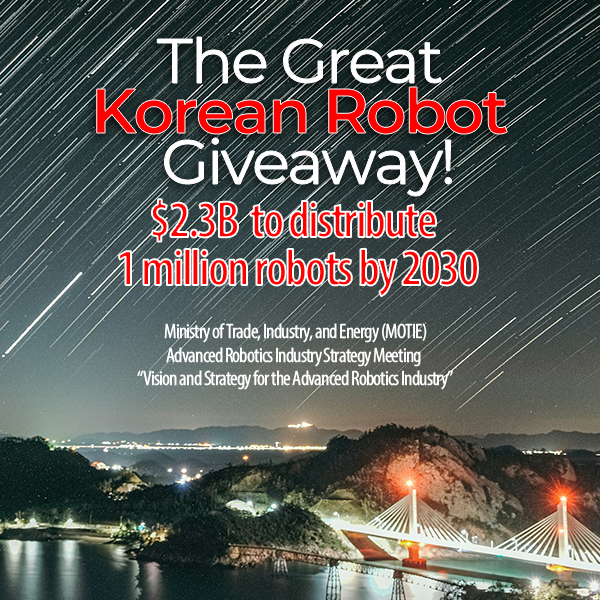
“The government plans to make efforts to foster the robot industry as a new growth engine while acquiring technology competitiveness that meets global standards.”
Korea to Distribute One Million Robots…for Free!
Government to foster K-robot industry as new growth engine
Korea pulls out all stops!
Korea’s blockbuster moves with its robotics industry since early in 2023 (Korean New Deal; $177B thru 2025) have bordered on the astounding. Korea seems to be pulling out all the stops in its efforts to counter the old-age epidemic, fewer workers, fertility rate collapse, and productivity slowdown.
2024 witnesses yet another investment bomb going off in Seoul to the tune of $2.3 billion into robotics. A public/private consortium will buy roughly one million robots (that’s Korean robots and cobots) for distribution throughout the country. With a population of 51 million and falling fast, one million robots average out to be like one per every 50 citizens. Unheard of anywhere else on Earth!
The move is in line with the government’s efforts to disseminate robot technologies into emerging industries such as space and aviation, as well as traditional manufacturing sectors, according to the Ministry of Trade, Industry and Energy (MOTIE). “The government plans to make efforts to expand investment and create new overseas opportunities in order to foster the robot industry as a new growth engine while acquiring technology competitiveness that meets global standards,” said Industry Minister Bang Moon-kyu.
A Ministry of SMEs & Startups
And the planning behind it is so robustly designed that Korea needs a nice round of applause for putting it together. Korea even has a special Ministry of SMEs and Startups (KOSME (founded in 2017, succeeding the former Small and Medium Business Administration)).
Every Country Should Have
a Ministry of SMEs & Startups!

The non-profit KOSME, with 10 regional offices throughout the country, will help with deploying the one million robots. In addition to sparking the competitiveness of SMEs (SME exports in 2023 were $111 billion) KOSME will double SME funding, train 10,000 new technologists, provide rental housing for 40,000, and generally support startups, micro-businesses, and the self-employed.
Some forecast results for 2030
Expectations are high.
In the segment for service robots Korea is also planning to raise the number of service robots to 700,000 by the 2030 target, leapfrogging the current estimate of 63,000.
The number of robot companies with annual sales above $75 million will also reach 30 by 2030, compared to just five that were tallied in 2021.
On the back of such efforts, the ministry expects the size of the local robot industry to reach more than $15 billion in 2030, rising sharply from the current $4.2 billion.
On Dec. 14, 2023: Ministry of Trade, Industry, and Energy (MOTIE) held an Advanced Robotics Industry Strategy Meeting presided over by Minister Bang Moon-kyu and announced the “Vision and Strategy for the Advanced Robotics Industry.” The focus is on fostering the robotics industry as a new growth engine that can enhance industrial productivity and adapt to demographic shifts, such as the decreasing working-age population.
Advanced robots hold substantial potential not only in traditional manufacturing sectors such as automotive and shipbuilding but also in the defense, aviation, and service industries. Furthermore, securing technological capabilities becomes more achievable with a robust foundation in domestic upstream industries like semiconductors, batteries, and information technology.
According to the MOTIE, the global market size is expected to grow rapidly from $28.2 billion in 2021 to $83.1 billion by 2030.
The government aims to solidify the domestic K-Robot ecosystem first and seek international expansion, targeting to elevate the market size from around 5.6 trillion won in 2021 to over 20 trillion won by 2030. To achieve this goal, there are plans for a joint public-private investment of “3 trillion won +α” to collaboratively enhance technology, manpower, and corporate competitiveness.
The government will initially focus on securing eight key technologies, including reducers and autonomous operation. A detailed technology development road map is set to be established by the first half of next year. In terms of workforce development, more than 15,000 specialized robotics professionals will be trained, aligning with the mobility industry, including future vehicles and drones, aiming to reach a total of 50,000 experts. Additionally, the goal is to nurture over 30 intelligent robotics specialist companies with annual revenue exceeding 100 billion won by 2030, an increase from the current five.
Furthermore, the government has set a goal to significantly expand the deployment of over one million robots across various sectors, ranging from manufacturing to logistics and welfare. Specifically, by 2030, the plan is to introduce 300,000 robots each in the care and medical sectors, including nursing homes and hospitals, as well as in the food and beverage self-employment sector, including restaurants and cafes.
The introduction of robots is expected to transform production sites, aiming to increase labor productivity per worker by an average of 3.4% per year and simultaneously reduce industrial accidents.
With a predicted decrease of 3.2 million in the working-age population from 2021 to 2030 alone, the collaboration with robots is seen as a strategic response to the changing labor market dynamics.
Read More>>Korea Business
Korean Gov’t Finalizes 4th Robot Plan
Advanced Robotics Industry Strategy Meeting:
A Global Expansion of K-Robot Fostering an Infrastructure Favorable to Advanced Robotics
See Related: Major Growth Spurt Ahead for Korean Robotics
Major Growth Spurt Ahead for Korean Robotics
2023-2026 Korea could leapfrog competition through integration of robotics, AI/ML, and ICT
